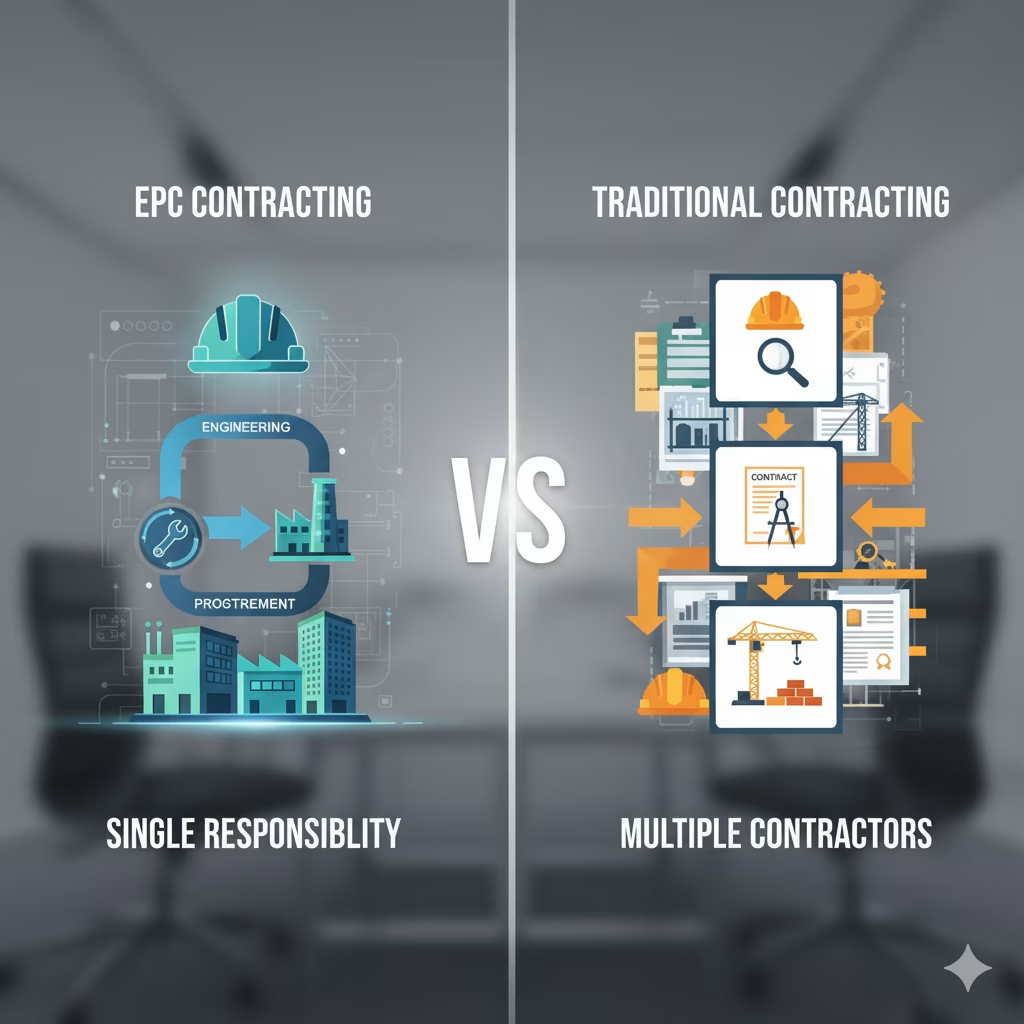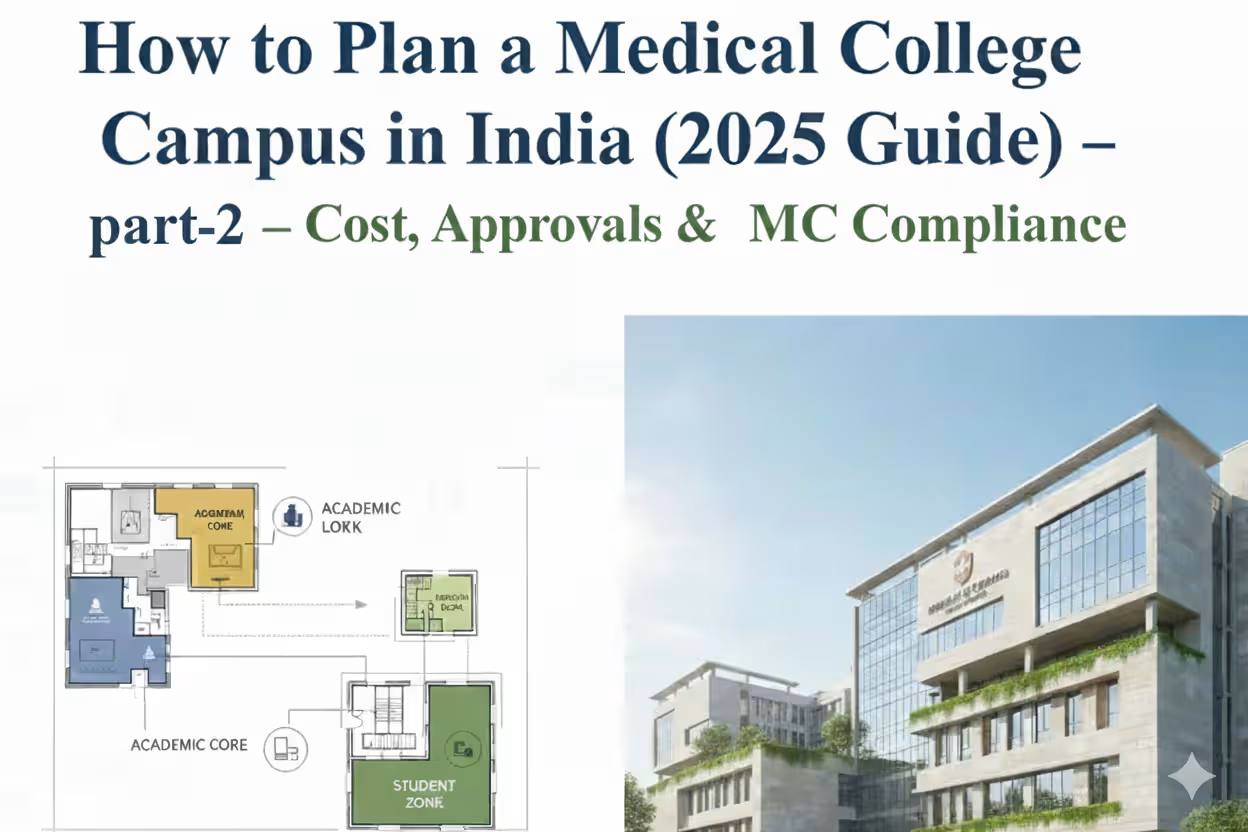EPC vs Traditional Contracting

Table of content
When planning a large construction project in India—be it a hospital, school, industrial plant, or CSR-funded community building the choice of contracting model can determine whether your project finishes on time and within budget. Studies show that over 60% of infrastructure projects face cost overruns or delays when contracting risks are poorly allocated (World Bank, 2023).
That’s why the debate of EPC vs Traditional Contracting (Design–Bid–Build) matters more than ever.
- EPC (Engineering, Procurement & Construction) offers a turnkey, single-point-of-responsibility model.
- Traditional contracting splits roles between designers, contractors, and the owner.
Each comes with advantages, trade-offs, and risks—from cost certainty and timelines to sustainability and CSR reporting. This guide will break down both models with clarity, so developers, corporates, NGOs, and CSR donors can choose the approach that best fits their vision.
If you don't want to mistake, Read: Hospital Construction Requirements in India 2025
EPC (Engineering, Procurement & Construction) is often called a “turnkey model”. Here, a single contractor (EPC company) takes responsibility for:
- Engineering/Design: Creating all technical drawings, specifications, and compliance documents.
- Procurement: Sourcing materials, labor, and subcontractors.
- Construction & Commissioning: Executing the build, testing, and handing over a fully operational facility.
The EPC contractor delivers a ready-to-use project, often at a lump-sum fixed price, and assumes most of the execution risk.
Common in power plants, oil & gas, hospitals, airports, and industrial facilities.
See, How to choose right consulting for your construction project
Traditional contracting, also known as Design–Bid–Build (DBB), separates the roles:
- Architect/Consultant prepares the design.
- Contractors bid on the construction scope based on those designs.
- Owner/Client coordinates between consultants, contractors, and vendors.
Here, risk is distributed among multiple parties, but the client plays a larger role in oversight.
Common in schools, offices, residential, and smaller-scale infrastructure projects.
University Construction Cost in India 2025
- Time Efficiency – EPC combines design, procurement, and construction under one roof. This parallel workflow can cut project timelines by several months.
- Cost Predictability – EPC projects are usually contracted on a lump-sum turnkey basis, ensuring fewer surprises in budget. For CSR boards, this means greater financial clarity and smoother reporting on how funds were used.
- Single Accountability – With one EPC partner responsible for the entire project, there’s no blame-shifting between architects, consultants, and contractors.
- Streamlined Communication – Dealing with multiple consultants, vendors, and contractors can be overwhelming. EPC ensures one point of contact, making governance and approvals more transparent.
- Integrated Sustainability – Unlike traditional models where green features are often add-ons, EPC allows sustainability to be baked in from day one. At BuiltX, we embed GRIHA/IGBC/EDGE compliance, water reuse strategies, and energy-efficient systems into design.
- Regulatory & Compliance Ease – EPC partners like BuiltX manage statutory approvals whether NABH for hospitals, NBC fire safety, or state NOCs, so NGOs and corporates can focus on impact instead of red tape.
- Design Freedom – Owners can retain greater creative and functional control. This works well in smaller, customized projects (like boutique offices or one-off cultural buildings) where design flexibility is a priority.
- Competitive Pricing – Since contractors bid on completed designs, clients may initially see lower prices. However, for CSR or NGO projects, cost escalations due to changes or delays can still be a risk.
- Owner Oversight – Clients play a more active role in monitoring construction quality and specifications. While this suits private developers with in-house teams, NGOs or CSR committees with limited technical staff may find this level of oversight challenging.
- Flexibility for Changes – Owners can adjust design mid-project (though usually at higher cost). This is beneficial for one-off builds but less suitable for time-sensitive CSR projects, where scope creep can delay community impact.
Affordable Sustainability for your next CSR project
- Pick EPC if…
- You’re building hospitals, schools, educational institutions, industrial units, renewable energy plants, or large infrastructure.
- You want speed, cost certainty, and a single accountable contractor.
- You’re building hospitals, schools, educational institutions, industrial units, renewable energy plants, or large infrastructure.
- Pick Traditional Contracting if…
- You’re building residential complexes, offices, or budget-conscious projects.
- You want design flexibility and don’t mind active involvement.
- You’re building residential complexes, offices, or budget-conscious projects.
Choosing between EPC vs Traditional contracting is not just about cost—it’s about control, accountability, and project risk. EPC shines when certainty and speed matter, while traditional contracting works best when flexibility and owner control are priorities.
But when it comes to CSR projects, EPC has a clear edge:
- Accountability for Donors – With a single EPC partner, there’s no confusion about who is responsible for delays or overruns. This means cleaner CSR reporting and impact assessment.
- Faster Project Delivery – CSR projects often have tight deadlines linked to financial year spends. EPC’s parallel design–build approach ensures timely completion.
- Certifiable Impact – EPC contracts can embed green building certifications, ESG metrics, and NABH/GRIHA compliance right into scope, giving donors auditable KPIs (energy saved, water recycled, CO₂ reduced).
- Risk Reduction – Donors don’t want their funds tied up in disputes between architects, contractors, and vendors. EPC shifts this risk away from NGOs and corporates.
At BuiltX , we guide CSR donors and NGOs in selecting the right contracting model, and for high-impact projects like hospitals, schools, and community infrastructure, EPC is often the most reliable way to deliver outcomes on time, on budget, and with measurable social impact.
Planning a CSR-funded hospital, school, or community center? Talk to BuiltX to explore how our EPC expertise can maximize your social impact while minimizing project risks.

.avif)